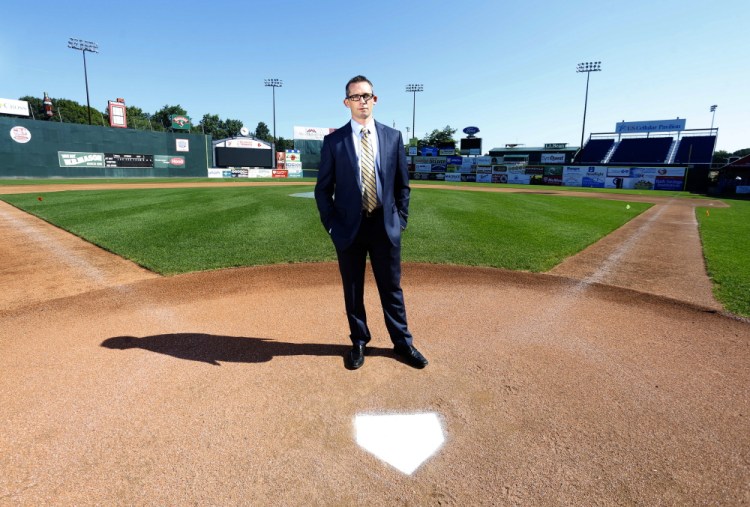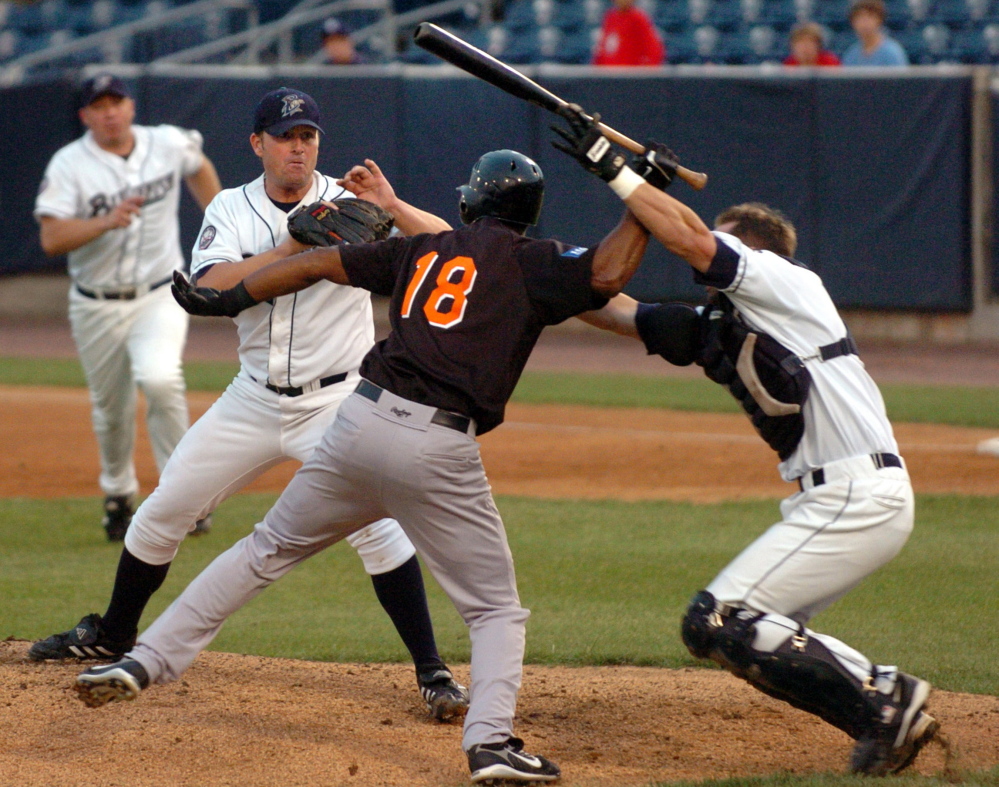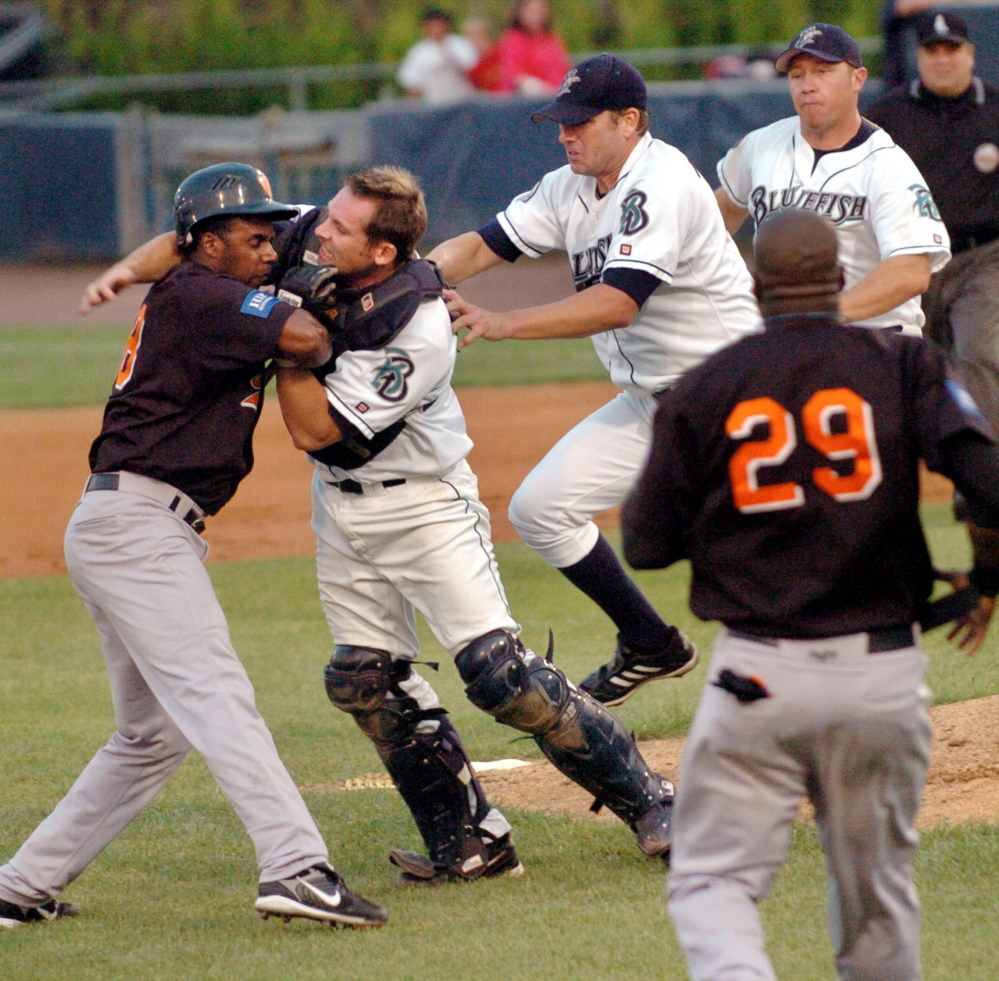Some professional baseball players achieve fame. John Nathans had to settle for notoriety. Chances are, if you recognize his name at all, it’s as a victim.
His career crash-landed seven years ago, in a melee near a pitcher’s mound, where he encountered a famous player waving a baseball bat overhead and ended up retching in the back of an ambulance.
Today, Nathans has found vindication and a sense of balance in his new hometown of Portland.
A seven-person jury ended his lengthy crusade for justice against Jose Offerman on July 29, awarding Nathans $940,000 for the head injuries he suffered in that brawl. As a result of the injuries, he takes three medications to battle daily headaches, attends weekly therapy sessions designed to help him master basic motor functions, and requires eyeglasses in order to walk a straight line.
“He took my baseball career; he wasn’t going to take the rest of my life,” Nathans said with quiet defiance last week at an Old Port restaurant, with his wife, Kate Lawrence of Gorham, at his side.
Nathans, 35, played seven professional seasons, including 2003 with the Portland Sea Dogs. The parent Boston Red Sox released the light-hitting catcher after a single at-bat in 2004.
But Nathans wouldn’t let go of his dream of reaching the major leagues, and he headed to the independent Atlantic League. It was in his third season there, playing for the Bridgeport Bluefish in Connecticut, that his fate became entwined with Offerman’s.
Offerman played 15 years in the major leagues and was a two-time All-Star, including in 1999 for the Red Sox. When the New York Mets let him go after the 2005 season, Offerman, then 36, wasn’t ready to retire either. Two years later, he was looking for another shot while toiling for the Long Island Ducks.
On Aug. 14, 2007, Offerman hit a home run off of Bridgeport pitcher Matt Beech, then returned to the plate in the second inning. This time, Beech’s second pitch hit him in the lower leg. Offerman started to walk to first, then veered toward the mound with bat in hand. Instinctively, Nathans tossed aside his helmet and face mask and raced to get between batter and pitcher.
There is no conclusive visual evidence of what happened next, as players from both teams scrambled to the center of the diamond. Nathans said he distinctly remembers feeling Offerman’s bat cracking into the back of his head, behind his right ear. Beech testified via video from his Texas home that he heard the sound of wood on skull as Offerman followed through after first breaking Beech’s middle finger. Offerman denied both swinging the bat and hitting Nathans.
It was soon clear to everyone, though, that Nathans was reeling. He stayed in the game to finish the second inning, but said the stadium lights felt like laser beams directed solely at him. He confused Beech’s replacement by signaling for pitches that he didn’t even throw.
When the inning ended, Nathans wobbled toward the dugout and then collapsed into it, vomiting. He was put on a stretcher and taken to the hospital in the same ambulance as Beech.
Offerman was charged with two counts of assault and received what amounted to two years of probation. He returned to his native Dominican Republic.
Nathans was diagnosed with a concussion, but the nausea, dizziness and headaches were unrelenting. The protocol called for him to be cleared if he strung together five consecutive days without symptoms. He never even managed one such day. He dropped 30 pounds from his 220-pound frame.
That offseason, he tried to resume some baseball activities, but he had no depth perception and found himself blindly stabbing at the ball as it was tossed to him. After he saw a succession of doctors, one finally delivered the bad news: His baseball career was over at age 28.
ALL HE EVER DREAMED
In his 254th and final professional baseball game, Nathans never even got to bat. His lifetime average will forever remain a meager .219. Still, he insists to this day that he would have found a way to make it to the major leagues if Offerman hadn’t intervened.
It was all Nathans ever dreamed of. The Warwick, New York, native went to Providence College, only to see the school drop his sport. He transferred to the University of Richmond, where he majored in political science but primarily studied baseball.
When no pro team drafted him, he started attending tryouts with hundreds of other hopefuls. At one, in Trenton, New Jersey, a scout from the Red Sox was impressed enough to sign Nathans. Two years later, he was in Portland, a Double-A team that would mark the highest level at which he would ever play.
There, he met Lawrence, a University of Southern Maine student who was a Sea Dogs intern that summer. One of her tasks was to transport Nathans and Slugger the mascot to a personal appearance at a South Portland elementary school. The two began dating, and have been together ever since.
Lawrence was in the stands that night in Bridgeport, although she was so close to the field that the players’ bodies blocked her view of what happened to her future husband. She learned he had collapsed after Beech phoned his girlfriend, seated next to Lawrence, from the clubhouse.
Lawrence called Nathans’ family, including younger brother Tucker, who was preparing for his freshman soccer season at Fairfield University. He was hardly prepared for what awaited him at the hospital.
“He wasn’t the same person,” said Tucker Nathans, now a 25-year-old infielder playing in the Baltimore Orioles’ minor-league system. “I can’t have a catch with him. He can’t throw batting practice to me. I lost part of my brother.
“He’s in that much pain that his personality can’t come out. If you know John, it’s not the same John that he was. (The injury has) had so many major effects that aren’t going away.”
In 2008, still having trouble functioning, John Nathans moved north to live with Lawrence and her friend in an Old Orchard Beach rental property. Lawrence was at the University of Maine School of Law by then, but helped Nathans convalesce. It was not pleasant.
“It was very limited as to what we could do,” Lawrence recalled. “There was a lot of sitting at home and trying to be quiet and trying to avoid places that had noises and flashing lights, which we still do.”
PURSUING PLAN B
In February 2009, Nathans filed a $4.8 million lawsuit against Offerman and the Ducks. At that point, it was unclear how much Nathans would accumulate in medical expenses, which were being covered by workers’ compensation insurance.
It was the beginning of a 51/2-year ordeal as attorneys tried in vain to locate Offerman so they could depose him. It’s almost unheard of for a case to drag on that long in federal court, said one his attorneys, Josh Koskoff.
By the fall of 2009, Nathans was ready to go to law school himself. His father, Bill, is a longtime real-estate lawyer in Warwick. It was always John’s plan to pursue that path once his baseball career was over, although trial law was his goal.
But first he had to pass the entrance examination, and that proved challenging. He failed the first time, buckled down and then passed on his second attempt. He also chose the University of Maine School of Law, whose law library in Portland just happens to overlook Hadlock Field.
“From the top floor, you can see down into the stadium,” Nathans said. “I used to sit up there and look down at the field and remember when I was playing down there. And I would think, when I was a catcher, I never would have looked up at the law library and imagined myself up there.”
Nathans needed to make peace with his sport. He had avoided attending games at his old stadium, the disappointment of how his career ended still too fresh.
The Sea Dogs reached out to him, asking if he’d like to throw out a first pitch. He wasn’t sure he wanted his last image of appearing on a baseball field to come while wearing bluejeans and an oversize jersey, a shadow of the athlete he once was.
Finally, he relented, and wondered why he had hesitated in the first place.
“It was very, very therapeutic,” Nathans said. “Me walking out to fans cheering, players out of the dugout, my old manager (Arnie Beyeler) in the dugout. It was special. I get choked up thinking about it right now.”
At law school, Nathans found himself in a tight-knit study group – which included former Portland Pirate player Matthew Libby – that he credits for helping him cope with the demands of his course work. His headaches sometimes meant he needed to leave class early. Friends would bring him copies of the notes he needed. Eventually, Nathans made the dean’s list.
He got paralegal and clerk jobs with the U.S. Attorney’s Office, the Cumberland County District Attorney’s Office and the Maine Superior Court. When Nathans got his degree and passed the bar in 2012, he set his sights on working for Peter DeTroy at his Portland law firm, Norman, Hanson & DeTroy.
DIDN’T WEAR IT ‘ON HIS SLEEVE’
DeTroy, a defense attorney, didn’t find out that Nathans was a former baseball player until the initial job interview. That helped Nathans’ cause.
“Athletes learn resilience,” DeTroy said. “Not every inning or at-bat is going to go well, but that’s not the end of it.”
It wasn’t until much later that DeTroy learned in an offhand conversation that Nathans was the guy from the Offerman incident.
“He didn’t wear that unfortunate situation on his sleeve,” DeTroy said. “That impressed me even more.”
DeTroy said Nathans has never asked for any workplace concessions as a result of his injury.
Nathans attends therapy sessions twice a week aimed at helping him manage the damage to his vestibular system, which controls balance and eye movement, among other things. His goal is to avoid the severe headaches that come when stimuli like lights and noise build up over the course of a day.
“Those are the shutdown headaches, blackout room, sheets over the head, game over,” he said.
The last time he suffered one of those?
“Two days ago.”
But he has never been stricken while in the courtroom, he said, and has no fear that he will.
“I come back to baseball,” Nathans said. “You don’t feel good every day when you play baseball. After the first day of spring training, something’s going to be aching every day. So what do you do? You put on the uniform, you go to work and you grind it out.
“It’s the same thing being a lawyer. You put on the uniform, you go to work and you grind it out. I have clients that count on me. I don’t have to hit a ball 400 feet anymore, so I can work within my limitations.”
FINDING TRIAL LAW FULFILLING
Nathans and Lawrence were married Aug. 16, 2009, shortly after she passed the bar and embarked on a career as a state prosecutor. It was two years and two days after the Bridgeport brawl.
The wedding was held outdoors in Phippsburg.
Lawrence kept her composure throughout. Nathans lost it during his vows.
He said he started thinking about all she had done for him, how far they had come together.
He had to stop the ceremony and apologize for crying.
“I’m an emotional person, yeah. But that was a surprise to me to be overcome that way,” Nathans said. “I hadn’t really thought about it in those terms.”
“I wasn’t surprised,” Lawrence said, as they looked at each other and started laughing at the memory.
There’s more to laugh about these days. Nathans finds trial law as fulfilling as he thought it would be. It’s a competition of a different sort every time he steps into a courtroom.
He loves living in Portland, saying the community has really embraced him, just as it did when he dislocated a shoulder sliding into second base for the Sea Dogs. People kept bringing him home-cooked meals while he healed, he said, still marveling at the memory.
He speaks to little brother Tucker after every one of his games. They rehash every at-bat.
“He’s known my swing for years,” Tucker said. “I ask him what pitch to look for in each situation. His job as a catcher was to out-think the hitters, so who better to ask?”
A $940,000 VERDICT
Nathans’ lawsuit was originally scheduled to go to trial in January in U.S. District Court in Bridgeport. But just before jury selection was to begin, Offerman finally surfaced and said he wanted to be involved in the proceedings after all. A six-month delay enabled him to travel from the Dominican Republic, where he is managing a baseball team, to sit for the long-awaited deposition.
The trial lasted 10 days. Nathans testified for two of them, seven hours in all. He was happy with the way he presented his case, but stung by what he called the “character assassination” of one of the defense witnesses, a neuropsychologist who insinuated that Nathans was making up his maladies.
It was the first time Nathans had seen Offerman since the night of the brawl. They still have never spoken to each other. Nathans said Offerman wouldn’t even make eye contact with him during the trial.
“People have forgiven people for far worse things than what Mr. Offerman did to me,” Nathans said. “Do I think I could sit down with him and have a conversation about this? Yeah, I do. But that would have to be him approaching me.
“I don’t have anything that I have to say to him. I’ve moved on.”
After five hours of deliberation, the jury returned with the finding that Offerman owed Nathans $940,000. The Ducks were declared to have no culpability in the on-field episode.
Nathans was pleased. So was Koskoff, but he cautioned:
“No case is over until the check is written.”
Indeed, Offerman’s attorney, Frank Riccio II, said they may appeal the verdict, which he called “inconsistent.”
“They found (Offerman) guilty of assault, but not battery,” Riccio said.
Does that mean the jury didn’t believe Offerman actually struck Nathans with his bat?
Koskoff dismissed the jury decision as a “legal wrinkle.”
Riccio has until the end of the month to file new motions, either with the same U.S. District Court or with the Court of Appeals.
“Both would like this chapter of their lives to move on and would like it to happen soon,” he said of Nathans and Offerman.
ACCEPTING HIS PLACE IN HISTORY
There’s the question of whether Nathans will ever see the money he has been awarded.
Offerman earned more than $32 million playing Major League Baseball. But Riccio’s late father, Frank, once withdrew from Offerman’s case over nonpayment of his fees.
The younger Riccio was asked if Offerman has the money. He paused for a long time.
“That’s a good question,” he said.
Koskoff would only say: “Jose Offerman is full of surprises. I’ll leave it at that.”
Nathans has no doubt that he’ll be paid. He wants to see justice done, and notes that the money is needed for his ongoing medical bills.
“The law doesn’t just allow juries to enter judgments and then for people to walk away from those judgments. There are legal ways to reach out and touch people’s assets,” he said. “If it takes me seven years, or 10 years, or 20 years or the rest of my life, that’s fine. I’ve got time.”
The trial renewed interest in Offerman and Nathans. The melee was widely publicized. So was the verdict.
It put Nathans back in the news, but not in the way that any athlete desires. Still, he’s not disturbed about his unusual place in baseball history.
“I’m known for going out and protecting my pitcher. I’ll take that,” Nathans said.
“I’d rather be known as that guy than the guy who didn’t go out, the guy who sat at home plate and watched his pitcher get beat.”
Send questions/comments to the editors.





Success. Please wait for the page to reload. If the page does not reload within 5 seconds, please refresh the page.
Enter your email and password to access comments.
Hi, to comment on stories you must . This profile is in addition to your subscription and website login.
Already have a commenting profile? .
Invalid username/password.
Please check your email to confirm and complete your registration.
Only subscribers are eligible to post comments. Please subscribe or login first for digital access. Here’s why.
Use the form below to reset your password. When you've submitted your account email, we will send an email with a reset code.